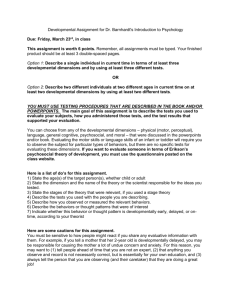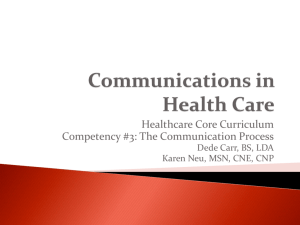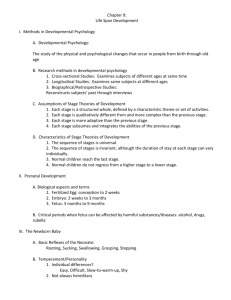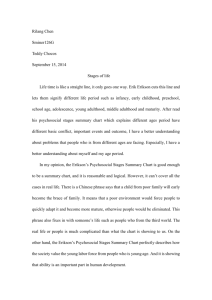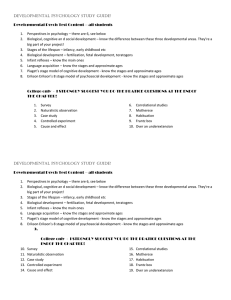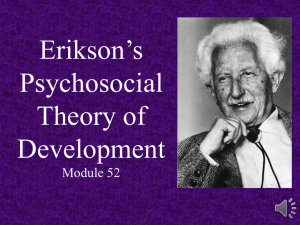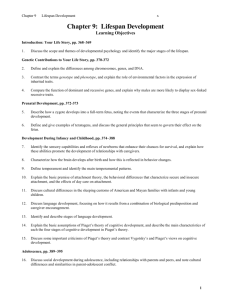AS Competency 1 Human Growth Development Models and Theories
advertisement
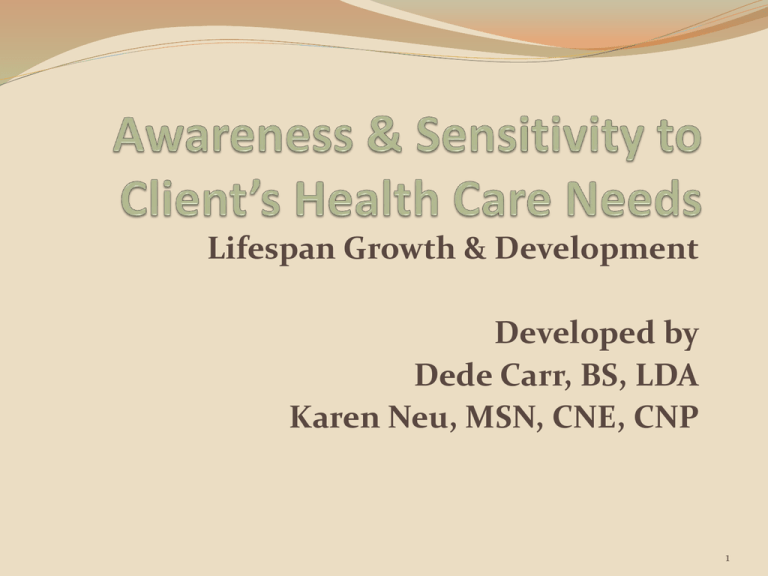
Lifespan Growth & Development Developed by Dede Carr, BS, LDA Karen Neu, MSN, CNE, CNP 1 U.S. Department of Labor Grant “This workforce solution was funded by a grant awarded by the U.S. Department of Labor’s Employment and Training Administration. The solution was created by the grantee and does not necessarily reflect the official position of the U.S. Department of Labor. The Department of Labor makes no guarantees, warranties, or assurances of any kind, express or implied, with respect to such information, including any information on linked sites and including but not limited to, accuracy of the information or its completeness, timeliness, usefulness, adequacy, continued availability, or ownership. This solution is copyrighted by the institution that created it. Internal use, by and organization and/or personal use by an individual or non-commercial purposes, is permissible. All other uses require the prior authorization of the copyright owner.” 2 Awareness & Sensitivity to Clients’ Health Care Needs Competency: Describe the major stages of human development & basic health needs of humans 1. Describe five common characteristics of growth and development. 2.Describe human needs theory regarding human actualization 3 “There's only one corner of the universe you can be certain of improving, and that's your own self.” Aldous Huxley “The great thing in the world is not so much where we stand as in what direction we are moving.” Oliver Wendell Holmes “The growth and development of people is the highest calling of leadership.” Harvey S. Firestone “You’ve got to do your own growing, no matter how tall your grandfather was.” Irish Saying “If you wish to achieve worthwhile things in your personal and career life, you must become a worthwhile person in your own self-development.” Brian Tracy 4 Growth Growth: Physical change & increase in size Indicators of Growth Height, Weight, Bone Size, & Dentition, Sensory Adaptation, & Development of sexual organs & characteristics Although physical growth is similar for all people, growth rates vary during different stages of growth & development Growth is rapid during prenatal, neonatal, infancy, & adolescence, but slows during childhood & is minimal during adulthood (Ramont & Niedringhaus) 5 Development Development: An increase in complex functions & progression of skills Development refers to a person’s capacity & skill to adapt to the environment Development is the behavioral aspect of growth & includes abilities to walk, talk, & run, speak, etc. (Ramont & Niedringhaus) 6 Principles of Growth & Development 7 Principles of Growth & Development Growth & development take place in an organized way, but do not progress at same rate with all individuals Cephalocaudally: Growth & development progresses from the head (cephalo) to tail (caudal); for example an infant gains head control before control of extremities Proximal to Distal: Growth & development progress from the center of the body outward-body’s midline to extremities (infant rolls before grasp is perfected) (Ramont & Niedringhaus) 8 Principles of Growth & Development General to Specific: Walking is learned before running or skipping Growth & development are independent, interrelated processes: Muscles, bones, & nervous system must grow to certain point before one can walk (Ramont & Niedringhaus) 9 Growth & Development Principles Growth & Development Continuous, orderly, & sequential processes influenced by maturity (age), the environment, & genetic factors Each stage is predictable, although the time of onset, length of stage, & effects of each stage varies with persons Each developmental stage has its own characteristics Development proceeds from simple to complex or from single acts to integrated acts (Ramont & Niedringhaus) 10 Growth & Development Principles Development becomes increasingly differentiated (advance from general response to skilled specific response) Example: An infant’s response to a stimulus involves the whole body while a five year old might respond with laughter (Ramont & Niedringhaus) 11 Growth & Development Principles Certain stages are more critical than others (1st 10-12 weeks after conception most critical—risks for defects from exposure to viruses, chemicals, & drugs) Uneven pace of growth & development (ex. Rapid spurts of growth during prenatal, neonatal, infancy, & adolescence periods) (Ramont & Niedringhaus) 12 Sequence of Development--Order for Infants 6 Months 2 Months Able to lift head up on his own 3 Months Can roll over 4 Months Can sit propped up without falling over Able to sit up without support 7 Months Begins to stand while holding onto things for support 9 Months Can begin to walk, still using support (All Psych & Heffner Media Group, Inc., ) 13 Sequence of Development--Order for Infants 10 Months Able to momentarily 14 Months Walk backward without support stand on her own without support 17 Months 11 Months Walk up steps with little /no support Stand alone with more confidence 18 Months 12 Months Manipulate objects with feet while walking, Begin walking alone such as kicking a ball without support 14 Factors that Influence Growth & Development Genetic inheritance—remains unchanged throughout life & determines characteristics: sex, physical stature, & race (Ramont & Niedringhaus) (www.saintbarnabas.com, n.d.) 15 Factors that Influence Growth & Development Environmental Family Religion Schools Climate Culture Community Nutrition (Ramont & Niedringhaus) (www.saintbarnabas.com, n.d.) 16 Growth & Development: Why is it important in health care? Knowledge of growth & development is essential when working in health care occupations because it is necessary to identify needs & problems (varies with age & developmental stage) & necessary to decide what & how to provide the appropriate health promotion/care needed. 17 Growth & Development: Why is it important in health care? It encompasses the prenatal period throughout the lifespan (fetus to neonate to old adult including physiological, psychosocial, cognitive, moral, & spiritual aspects of each life stage) Remember how you care for someone will depend on their age, size, mental, physical, & emotional abilities—(growth & development) (Ramont & Niedringhaus) 18 Components of Human Growth & Development 19 Relationship between Growth & Development Each person’s rate of growth & development is highly individualized, but sequence (progress) is predictable 20 Five Major Components of Growth & Development Physiological: Relates to human body Psychosocial: Relationship between oneself & others; emotions (love, hate, fear, anxiety, joy), attitudes Cognitive: An awareness of & interaction between oneself & environment; development of intelligence, conscious thought, & problem-solving ability that begins in infancy Moral: Relates to judgments of right & wrong Spiritual: Pertains to relationship with a higher power (God) (Ramont & Niedringhaus) 21 Life Stages & Developmental Tasks As people mature from infancy to old age, persons pass through several developmental stages as identified in each of the five components of growth & development Developmental tasks have to be accomplished at each of the developmental stages in order for the person to progress. There are several developmental tasks that one should achieve in each of the physiological, psychosocial, cognitive, moral, & spiritual growth experiences (Ramont & Niedringhaus) 22 Physiologic Component 23 Physiological Component Pertains to the “body” Growth: Physical change & increase in size; Can be measured quantitatively Indicators of growth includes height, weight, bone size, & dentition Growth rates vary during different stages of growth & development Growth rate is rapid during the prenatal, neonatal, infancy & adolescent stages & slows during childhood 24 Physical growth is minimal during adulthood Physiological Component Development of the Body: Increases in the complexity of functions & skills progression (what a person can do, such as walking, running, skating, feeding self, etc.) Capacity & skill of a person to adapt to the environment Development is the behavioral aspect of growth (Ramont & Niedringhaus) 25 Cognitive Component 26 Cognitive Component The cognitive theory cited most often in the cognitive development in children is Jean Piaget’s (1896-1980) theory. (All Psych & Heffner Media Group, Inc., ) 27 Cognitive Component As with all stage theories, Piaget’s Theory of Cognitive Development maintains that children go through specific stages as their intellect & ability to see relationships matures These stages are completed in a fixed order with all children, even those in other countries The age range, however can vary from child to child (All Psych & Heffner Media Group, Inc., ) 28 Piaget’s Theory of Cognitive Development Cognitive refers to the process of acquiring knowledge by the use of reasoning, intuition, or perception; relating to thought processes (Encarta Dictionary) (All Psych & Heffner Media Group, Inc., ) 29 4 Stages of Piaget’s Theory of Cognitive Development Sensorimotor Stage [0-2 years] Preoperational Stage (Divided into 2 Phases) Preconceptual [2-4 years] Intuitive [4-7 years] Concrete Operations Stage [7-11/12 years] Formal Operations Stage [11/12 years & upwards] (All Psych & Heffner Media Group, Inc., ) 30 Piaget’s Cognitive Development 31 Cognitive Component of Growth & Development See the following slides for explanations and examples of each of the stages of Piaget’s Theory of Cognitive Development as depicted on the diagram. Think of someone you know for each of the stages of cognitive development. 32 Cognitive Stage #1: Sensorimotor Stage (Birth – 2 years) During this stage, child learns to manipulate objects although they fail to understand the permanency of these objects if they are not within their sight (current sensory perception). In other words, once an object is removed from the child’s view, he/she is unable to understand that the object still exists. Major achievement is Object Permanency (ability to understand that these objects do in fact continue to exist) Includes child’s ability to understand that when mom leaves the room, she will eventually return, resulting in an increased sense of safety & security Object Permanency occurs during end of this stage & represents child’s ability to maintain a mental image of the object (or person) without the actual perception or seeing the object (or person) (All Psych & Heffner Media Group, Inc., ) [Image from www.lobo.sbc.edu] 33 Stage #2: Preoperational Stage Stage #2--Phase #1: Preconceptual (2-4 years) Marked by “Egocentrism” (Child’s belief that everyone sees the world the same way that he/she does) Everything is significant & relates to “me” Child explores the environment Develops language at a rapid pace Associates words with objects Child fails to understand the differences in perception & believes that inanimate objects have the same perceptions the child does, such as seeing things, feeling, hearing & the sense of touch (All Psych & Heffner Media Group, Inc., ) 34 Stage #2: Preoperational Stage Stage #2-Phase #2 Intuitive Thought (4-7 years) Children learn how to interact with their environment in a more complex manner through the use of words & images Egocentric (“me”) thinking diminishes; child thinks of one idea at a time Includes others in the environment & learns to play with their peers, increasing the number of friends as they grow older Child’s words express thought & they learn about feelings: cry, sad, laugh related to the words Child gradually emerges as social beings (Berman et al., p. 210) (www.littlescholarspreschoolfl.com, n.d.) 35 Stage #2: Preoperational Stage A second important factor in this stage is that of conservation (ability to understand that quantity does not change if the shape changes) In other words, if a short & wide glass of milk is poured into a tall & thin glass, children will perceive the taller glass as having more milk due only because of it’s height Children’s inability to understand reversibility & their focus on only one aspect of a stimulus is called centration; (Focus is only on height as opposed to understanding other aspects as glass width) (All Psych & Heffner Media Group, Inc., ) (www.clips.tojsiab.com, n.d.) 36 Cognitive Stage #3: Concrete Operations Between ages 7-11/12 years Stage #3 is marked by a gradual decrease in centristic thought & the increased ability to focus on more than one aspect of a stimulus or item Children can understand the concept of grouping, knowing that a small dog & a large dog are still both dogs, or that pennies, quarters, & dollar bills are part of the bigger concept of money They can only apply this new understanding to concrete objects (those they have actually experienced) In other words, imagined objects or those they have not seen, heard, or touched continue to remain somewhat mystical to these children, & abstract thinking has yet to develop (All Psych & Heffner Media Group, Inc., ) 37 Cognitive Stage #4: Formal Operations (12 years & Beyond) Children begin to develop a more abstract view of the world They are able to apply reversibility & conservation to both real & imagined situations; They develop an increased understanding of the world & the idea of cause & effect By teenage years- they are able to develop their own theories about the world; Stage #4 is achieved by most children, although failure to do so has been associated with lower intelligence Early in the period there is a return to egocentric (focus on “me”) thought (All Psych & Heffner Media Group, Inc., ) 38 Cognitive Stage #4: Formal Operations (12 years & Beyond) Moving from concrete to formal thinking, & driven by a sense of urgency, teens may want it all, right here, right now! Not unlike the terrible twos, teens are craving to break loose, to look at the other side of the fence, & to take a walk on “the wild side” Teens fight for the emergence of their own will, while seeking love from trusted ones Teenagers are on a quest to answer satisfactorily & happily the question "Who am I?" They will seek the leadership of chosen others, & gradually develop a set of ideals, socially congruent & desirable in the case of successful integration; furthermore, in the process of growing up they will acquire a sense of self worth & establish clear sexual identities (Lego Group) 39 Moral Component 40 Kohlberg’s Levels of Moral Development Kohlberg’s (1973) stages of moral development breaks our development of morality into three levels, each of which is divided further into two stages: Pre-conventional Level (up to age nine): ~Self Focused Morality~ Conventional Level (age nine to adolescence): Other Focused Morality~ Post-conventional Level (adulthood): ~Higher Focused Morality~ (Ramont & Niedringhaus, p. 208) 41 Kohlberg’s Levels of Moral Development Pre-conventional Level (up to 9 years): Self-focused morality Morality is defined as obeying rules & avoiding negative consequences Children in this stage see rules set, typically by parents, as defining moral law That which satisfies the child’s needs is seen as good & moral—most actions taken by the child are to satisfy the child’s own needs They believe that activity is wrong if one is punished & activity is right if one I not punished (Ramont & Niedringhaus, p. 208) 42 Kohlberg’s Levels of Moral Development Conventional Level (9 years to adolescence): Other -focused morality (think of others rather than self) Children begin to understand what is expected of them by their parents, teacher, etc. Morality is seen as meeting or achieving these expectations Fulfilling obligations as well as following expectations are seen as moral law for children in this stage Action is taken to please another & gain approval Right behavior is obeying the law & following the rules (Ramont & Niedringhaus, p. 208) 43 Kohlberg’s Levels of Moral Development Post-conventional Level (adulthood): Higher-focused morality Adults begin to understand that people have different opinions about morality & that rules & laws vary from group to group & culture to culture Morality is seen as upholding values of one’s group or culture Understanding one’s own personal beliefs allows adults to judge themselves & others based upon higher levels of morality What is right & wrong is based upon the circumstances surrounding an action (Ramont & Niedringhaus, p. 208) 44 Kohlberg’s Stages of Moral Development Post-conventional Level (adulthood): Basics of morality are the foundation with independent thought playing an important role Standards of behaviors are based on adhering to laws that protect the welfare & rights of others Personal values & opinions are recognized, & violating the rights of others is avoided Universal moral principles are internalized The person in this stage respects other humans & believes that relationships are based on mutual trust (Ramont & Niedringhaus, p. 208) 45 Psychosocial Component 46 Psychosocial Component Development of Personality Psychosocial development refers to the development of personality, a complex concept—difficult to define Consider as outward (interpersonal) expression of inner (intrapersonal) self Encompasses a person’s temperament, feelings, selfesteem, character traits, independence, self-concept, behavior, ability to interact with others, & ability to adapt to life changes (Berman et al., p. 350) The following slides show the stages, age range, & Erikson’s Psychosocial Stages (central tasks) 47 Psychosocial Component of Growth & Development Psychosocial aspects of each life stage are based on Erikson’s Stages of Psychosocial Development Erikson studied human responses to life’s events to gain an understanding of how attitudes & behaviors change throughout the lifespan In each stage, Erikson believed people experience a conflict that serves as a turning point in development (Berman et al., p. 350) 48 Erikson’s Psychosocial Developmental Stages Conflicts centered on either developing a psychological quality or failing to develop that quality During these times of conflict, the potential for personal growth is high, but so is the potential for failure to accomplish the devel0pmental tasks Once the conflicts are successfully resolved the individual advances to the next stage of development (Berman et al., p. 350) 49 Erikson’s Psychosocial Stages of Development Stage Age Erikson Stage Prenatal Conception - Birth Infancy Birth – 1 year Trust vs. Mistrust Toddler 1 – 3 years Autonomy vs. Shame/Doubt Preschooler 3 – 6 years Initiative vs. Guilt 50 Erikson’s Psychosocial Stages of Development Stage Age Erikson Stage School-Age Child 6 – 12 years Industry vs. Inferiority Adolescence 12 – 20 years Identity vs. Role Confusion Young Adulthood 20s and 30s Intimacy vs. Isolation Middle Adulthood 40s and 50s Generativity vs. Stagnation Later Adulthood 60s to death Ego Integrity vs. Despair 51 Video Explanation of Developmental Stages See the following U-Tube Videos showing Erikson’s Psychosocial Stages of Development The first video presents all eight stages Erikson's Psychosocial Stages This video presents only the first four stages, but explains them well. Erikson's Psychosocial Stages of DevelopmentFirst Four (www.parents.lego.com, n. d.) 52 Infancy: Trust versus Mistrust Infant is totally dependent for cares: feeding, diapering, bathing, comforting, etc. Development of trust based on the dependability & quality of caregivers If a child successfully develops trust, child will feel safe & secure in the world Caregivers who are inconsistent, emotionally unavailable, or rejecting contribute to feelings of mistrust in the children they care for. Failure to develop trust will result in fear & a belief that the world is inconsistent & unpredictable (Berman et al., p. 350) 53 Developmental Tasks of Infancy Establishes a trusting, meaningful relationship; recognizes the primary caregiver, develops attachment behavior Learns to recognize objects, develops exploration skills & can predict responses to environment Develops communication skills by beginning vocalization, develops nonverbal communication system, & imitates simple vocalization (cooing sounds) Develops muscular control, eye-hand coordination, & object manipulation Develops mobility: crawling, creeping, cruising, & walking Establishes patterns of living: eating, sleeping, & elimination habits Begins to develop independent living skills, including selffeeding, walking, undressing, & communication of needs (Polan, p. 163) 54 Toddler/Early Childhood Autonomy versus Shame & Doubt Ages: 18 months- 3 years Begin to assert their independence, by walking away from mother, picking toy to play with, & making food choices, clothing to wear, Focus on developing a greater sense of personal control Learning to control one’s body functions leads to a feeling of control & a sense of independence (Toilet training) (Ramont & Niedringhaus, pp. 206-209) 55 Toddler/Early Childhood Autonomy versus Shame & Doubt If encouraged-become successful: feel secure & confident If criticized, overly controlled, or not given opportunities to assert: will develop a sense of inadequacy, self-doubt & shame, lack of self-esteem, overly dependent on others (doubt abilities) (Ramont & Niedringhaus, pp. 206-209) 56 Developmental Tasks of Toddlers Recognizes self as a separate person; tolerates separation from primary caregiver, expresses own ideas & needs Develops increased attention span Begins to develop communication skills Masters toilet-training basics Achieves independent mobility Develops independent skills of daily living, feeding, dressing, toileting, managing simple tasks (Polan, p. 166) 57 Late Childhood: Initiative vs. Guilt Preschool years: 3-5 years Begin to assert their power & control over the world through directing play, planning activities, making up games, initiating activities with others, & other social interaction If successful, children develop a sense of initiative; feel secure in their ability to lead others & make decisions. Those who fail are left with a sense of guilt, self-doubt and lack of initiative (Ramont & Niedringhaus, pp. 209-210) 58 Developmental Tasks of Preschoolers Develops stronger sense of self; can express own needs, ideas, & feelings, can postpone immediate gratification Attains greater attention span; listens more attentively Develops & refines gross motor skills & fine motor skills Recognizes sex identification Begins to work & play more cooperatively with others Improves communication skills Develops self-control skills, learns socially acceptable ways of expressing anger, frustration, & disappointment; obeys simple rules; develops self-awareness & sense of self-protection Seeks information, asks questions, learns values & beliefs of family (Polan, p. 169) 59 School Age Industry versus Inferiority School age: 6-12 years Through social interactions, children begin to develop a sense of pride in their accomplishments & abilities In encouraged, reinforced for initiatives, & commended by parents & teachers, children will begin to feel industrious, develop a feeling of competence & belief ability to achieve goals & in their skills If children receive little or no encouragement from parents, teachers, or peers they will feel inferior & doubt their ability to be successful (Ramont & Niedringhaus, pp. 210-211) 60 Developmental Tasks of School-Age Develops a sense of belonging with family, peers Develops work habits; learns to organize, set & reach goals, evaluate work, accept criticism Learns competence in reading, writing, calculation, grammar, & communication Refines fine & gross motor coordination (Polan, p. 171) 61 Adolescence: Identity vs. Confusion Adolescence: 12/13 to 20 years Exploring their independence, developing a sense of self, & beginning to look at the future in terms of career, relationships, families, housing, etc. In forming their identity, students will begin to think about who they are, where they are going & how they fit in; may try new hairstyles, experiment with new clothing styles, & form a group of people with whom they hang out (Ramont & Niedringhaus, pp. 211-213) 62 Adolescence: Identity vs. Confusion If they receive proper encouragement & reinforcement through personal exploration will emerge with a strong sense of self & a feeling of independence & control Those who remain unsure of their beliefs & desires will become insecure & confused about themselves & the future (Ramont & Niedringhaus, pp. 211-213) 63 Developmental Tasks of Adolescents Recognizes individuality Accepts strengths & weaknesses Develops own value system Assumes responsibility for one’s behaviors Develops philosophy of life Adapts to somatic (body) changes Acquires skills necessary for adult living Refines social skills Develops independent living skills (Polan, p. 174) 64 Young Adult: Intimacy vs. Isolation Early Adulthood: 18-25 years Exploring personal relationships: it’s vital that people develop close, committed relationships with other people If successful, adult will develop secure relationships with a sense of commitment, safety, & care within the relationship (Ramont & Niedringhaus, p. 214) 65 Young Adult: Intimacy vs. Isolation Must have a strong sense of personal identity to develop intimate relationships Those with a poor sense of self tend to have less committed relationships & are more likely to suffer emotional isolation, loneliness, & depression (Ramont & Niedringhaus, p. 214) 66 Developmental Tasks of Young Adult Achieves independence financially & socially Maximizes personal worth & identity Develops meaningful & satisfying social relationships Assumes responsibilities & independent decision-making Learns to balance personal needs & societal expectations Accepts self & others Distinguishes physical attraction from love & permanent commitment Decides on marriage, career, & children (Polan, p. 176) 67 Middle Adulthood: Generativity versus Stagnation Middle Adulthood: 25- 65 years Continue to build lives, need to create or nurture things that will outlast them by focusing on career & family or creating a positive change that benefits other people. Give back to society: establish careers by being productive at work; settle down within a relationship; begin families & develop a sense of being a part of the bigger picture by involvement in community activities & organizations (Ramont & Niedringhaus, pp. 214-216) 68 Middle Adulthood: Generativity versus Stagnation If successful, individuals will feel they are contributing to the world (active in their home & community); feelings of usefulness & accomplishment Those who fail to attain this skill will feel unproductive& uninvolved in the world which results in shallow involvement in the world (Ramont & Niedringhaus, pp. 214-220) 69 Developmental Tasks of Middle Adulthood Balances goals & realities & redirects energies as necessary Extends caring & concern beyond immediate family (to neighborhood, community, & society) Develops career/job satisfaction Adapts to physical changes Establishes new roles & relationships with spouse, children, grandchildren, & parents (Polan, p. 177) 70 Young-Old Adult Integrity vs. Despair Young-Old Adult: 65 years to 74 years Adaptation to retirement & changing physical abilities Maintain physical & social activities; Maintain peer group interactions Those who feel proud of their accomplishments will feel a sense of integrity; successfully look back with few regrets & a general feeling of satisfaction; will attain wisdom, even when confronting death If unsuccessful, individuals will feel that their life has been wasted & will experience many regrets, leaving the individual with feelings of bitterness & despair (Ramont & Niedringhaus, pp. 214-220) 71 Middle-Old Adult: Integrity vs. Despair Middle-Old Adult: 75 years to 84 years Adaptation to decline in speed of movement, reaction time, & increasing dependence on others may be necessary Assist clients to cope with loss (hearing, sensory abilities, eyesight, death of loved one, independence) Must consider safety measures Those who feel proud of their accomplishments will feel a sense of integrity; successfully look back with few regrets & a general feeling of satisfaction; will attain wisdom, even when confronting death If unsuccessful individuals will feel that their life has been wasted & will experience many regrets, leaving individual with feelings of bitterness & despair (Ramont & Niedringhaus, pp. 214-220) 72 Old-Old Adult: Integrity vs. Despair Old-Old Adult: 85 years and older Increasing physical & sometimes mental acuity problems may develop Those who feel proud of their accomplishments will feel a sense of integrity; successfully look back with few regrets & a general feeling of satisfaction; will attain wisdom, even when confronting death If unsuccessful individuals will feel that their life has been wasted & will experience many regrets, leaving the individual with feelings of bitterness & despair (Ramont & Niedringhaus, pp. 214-220) 73 Developmental Tasks of Late Adulthood Accepts own life Recognizes accomplishments Finds satisfaction with new roles, relationships, & leisure time Maximizes independence & maintains high level of involvement Accepts own mortality & prepares for death (Polan, p. 185) 74 Spiritual Component 75 Spiritual Component Spiritual-Development of Faith as a force that gives meaning to a person’s life Faith – “a form of knowing, a way of being in relation to an ultimate environment” Faith- “an active ‘mode-of-being-in-relation’ to another or others in which we invest commitment, belief, love, risk, & hope” (Fowler & Keen, 1985, p. 18 as cited in Berman et al., p. 361) Development of faith – an interactive process between the person & environment (Fowler, Streib, Keller, , as cited in Berman et al., p. 361) Fowler’s spiritual theory was influenced by Piaget, Kohlberg, & Erikson (Berman et al.) 76 Spiritual Component In each of Fowler’s stages of spiritual development, new patterns of thoughts, values, & beliefs are added to those already held by the individual; (Berman et al., p. 361) Therefore the stages follow in sequence (order) Fowler’s spiritual stages evolve from a combination of knowledge & values (Berman et al., p. 361) The following slides depict Fowler’s Stages of Spiritual Development & give a general age range of when individuals progress in developmental sequence. Which stage of spiritual development do you find yourself? Consider why you are at that stage. 77 Spiritual Development Fowler’s Stages of Development Stage #0: Undifferentiated (0-3 years of age) Description Infant is unable to formulate concepts about self & the environment (Ramont & Niedringhaus, p. 209) 78 Spiritual Development Component Stage #1 Intuitive-predictive (3-7 Years) Egocentric, becoming aware of time Combination of images & beliefs given by trusted others (parents), mixed with child’s own experience & imagination Will affect their later life (Ramont & Niedringhaus, p. 209) Stage #2 Mythical-literal (6-12 Years) Private world of fantasy & wonder; symbols refer to something specific Dramatic stories & myths used to communicate spiritual meanings Aware of the stories & beliefs of the local community & Uses these stories to give sense to their experiences. 79 Spiritual Development Component Stage #3 Synthetic-conventional (12 Years to Adult) Extend faith beyond the family & use this as a vehicle for creating a sense of identity & values World & ultimate environment structured by expectations & judgments of others Interpersonal focus Stage #4 Individuative-reflective (Early Adults) Sense of identity & outlook on the world are differentiated & the person develops explicit systems of meaning Constructing one’s own explicit system; high degree of self-consciousness Takes personal responsibility for his/her beliefs & feelings (Ramont & Niedringhaus, p. 209) 80 Spiritual Development Component Stage #5 Conjunctive or Paradoxical-Consolidative (Adult) Person faces up to the paradoxes of experience & begins to develop universal ideas & becomes more oriented towards other people Awareness of truth from a variety of viewpoints Stage #6 Universalizing (Adult) Person becomes totally altruistic & they feel an integral part of an allinclusive sense of being Become an incarnation of principles of love & justice This stage is rarely achieved (Ramont & Niedringhaus, p. 209) (Ramont & Niedringhaus, p. 209) 81 References All Psych & Heffner Media Group,Inc. (1999-2003). Psychology 101: Personality development. Retrieved from http://allpsych.com/psychology101/development.html Berman, A., Snyder, S.J., Kozier, B., & Erb, G. (2008). Concepts of growth & development. In A. Berman, S.J. Snyder, B. Kozier, & G. Erb (Eds.). Kozier & Erb’s Fundamentals of nursing: Concepts, process, and practice (8th ed.) (pp. 348-365). Upper Saddle River, NJ: Prentice Hall Berman, A., Snyder, S.J., Kozier, B., & Erb, G. (2008). Health promotion. In A. Berman, S.J. Snyder, B. Kozier, & G. Erb (Eds.). Kozier & Erb’s Fundamentals of nursing: Concepts, process, and practice (8th ed.) (pp.270-293). Upper Saddle River, NJ: Prentice Hall 82 References Juliar, K. (2003) Minnesota Healthcare Core Curriculum (2nd ed.). Clifton Park, NY: Delmar Publishers Lego Group. (2011). Your 12+ year old teens: Becoming an adolescent. Retrieved from http://parents.lego.com/engb/ChildDevelopment/CD%2012+yrs.aspx Ramon, P.R. & Niedringhaus, D. M. (2008). Life span development. Fundamental nursing care (2nd ed.) (pp. 197-223). Upper Saddle River, NJ: Person Prentice Hall Schmutte, D. L. (2011). Maslow’s Hierarchy of Needs. Retrieved from http://www.enotes.com/nursing-encyclopedia/maslow-s-hierarchy-needs Simons, D.J., Drinnien, I. & Drinnien B.A. (1987). The search for understanding. Retrieved from http://honolulu.hawaii.edu/intranet/committees/FacDevCom/guidebk/te achtip/maslow.htm United States Army. (2004-2008). Categories of basic human needs. Retrieved from http://www.freeed.net/sweethaven/MedTech/NurseFund/default.asp?iNum=2&fraNum=0 10102 83
